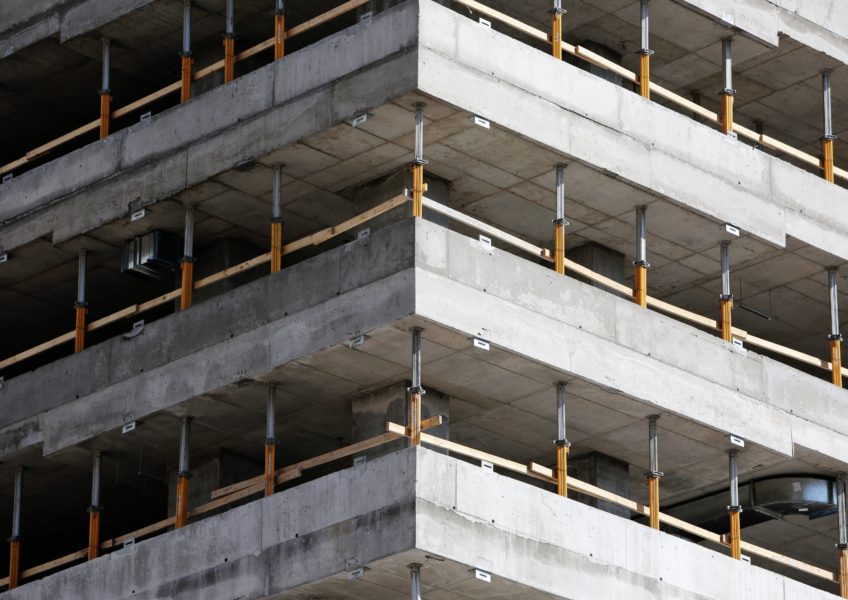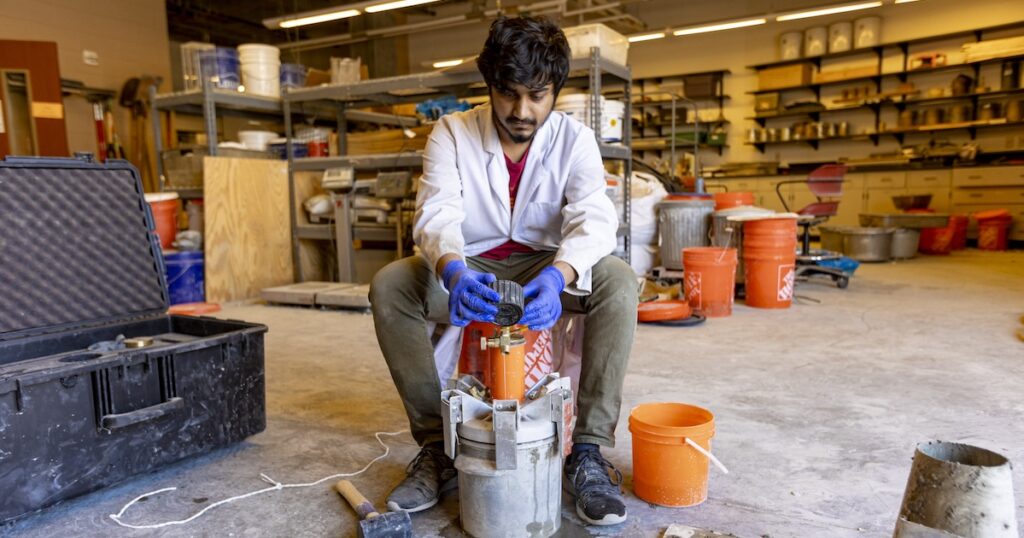The Necessary Function of Concrete Structure in Structural Stability and Longevity
When it concerns building a residential or commercial property, the foundation is more crucial than you might think. Concrete structures supply unequaled stamina and sturdiness, ensuring your structure can withstand numerous ecological obstacles. Without a strong base, you take the chance of potential problems like shifting or splitting, which can jeopardize security and worth. Recognizing the nuances of concrete foundations could be the key to preserving your financial investment for years to come. What should you think about following?
Recognizing the Value of Concrete Foundations
Concrete structures are essential to the total stability of any kind of framework, as they provide the essential support required to endure numerous loads and ecological problems. When you consider building a home or an industrial room, the foundation is the initial thing you should take into consideration. It functions as a barrier versus wetness, securing your residential or commercial property from water damages. A well-placed concrete structure likewise prevents settling and changing, which can lead to fractures in wall surfaces and floors. You'll wish to assure that the foundation is effectively developed and strengthened, as this affects the long life of your structure. Additionally, a strong structure can improve energy performance by minimizing air leaks. Keep in mind, neglecting the importance of a concrete structure can result in costly repairs down the line. Spending in a top quality structure upfront is crucial for the honesty and toughness of your framework.
Benefits of Concrete Structures for Architectural Stability
While numerous factors add to a building's architectural stability, concrete foundations supply unparalleled longevity and stamina. You'll appreciate that concrete can hold up against severe weather, withstanding both moisture and temperature level changes. This durability means your framework is less likely to experience cracking or changing with time, which can endanger its safety.Additionally, concrete's integral weight supplies a strong base, protecting against activity throughout all-natural occasions like quakes or floodings. When you choose a concrete structure, you're also going with low upkeep; unlike wood, it won't rot or attract bugs, conserving you money and time in repairs.Moreover, concrete's fire resistance supplies added safety and security, ensuring your framework can endure heats without considerable damages. Generally, buying a concrete structure implies you're focusing on the long-lasting security and stability of your building, making it a smart option for any building and construction job.
Usual Kinds Of Concrete Foundations
When it comes to developing structures, comprehending the common sorts of concrete structures can help you make educated options for your project. The most widespread types consist of slab-on-grade, crawl space, and complete cellar foundations.A slab-on-grade foundation is a straightforward, cost-efficient option, where a thick concrete piece is put directly on the ground. This kind works well in cozy environments, as it reduces warmth loss.Crawl area foundations raise the home slightly above ground, permitting for ventilation and access to plumbing and electrical systems. This design can help avoid wetness issues.Full basement foundations offer additional living or storage room while giving excellent architectural support. They require even more excavation and are normally made use of in cooler environments to avoid frost heave.
Variables to Consider When Creating a Concrete Structure

Ideal Practices for Putting Up Concrete Foundations
When you're mounting a concrete structure, appropriate site prep work is vital to ensure security (West Coast General Engineering commercial concrete). You'll likewise need to recognize reinforcement techniques to improve strength and toughness. Finally, don't neglect the treating procedure, as it plays an essential role in accomplishing a solid structure
Site Prep Work Value
It might seem uncomplicated, correct website preparation is essential for ensuring a strong and resilient concrete structure. Beginning by getting rid of the area of any type of debris, greenery, or organic material that could compromise the structure's honesty. Next, analyze the dirt kind and compaction; you might need to dig deep into or add products to create a stable base. Degree the ground to guarantee even weight distribution and avoid clearing up issues later. Mounting correct drainage systems is also vital to stop water build-up, which can compromise the structure gradually. Mark out the foundation's measurements precisely to assist the putting procedure. By adhering to these steps, you'll set the phase for a successful concrete structure that stands the test of time.
Reinforcement Techniques Discussed
When the site is appropriately prepared, the following action in ensuring a strong concrete structure includes implementing effective support strategies. You need to begin by utilizing steel rebar, which provides tensile toughness and aids protect against breaking. Lay the rebar in a grid pattern, seeing to it it rises using spacers to preserve correct protection. In addition, think about using cable mesh for added assistance, specifically in locations subject to hefty lots. Do not fail to remember to link the rebar intersections securely with wire. For larger foundations, fiber support can improve toughness, reducing the threat of shrinking cracks. Always adhere to neighborhood structure codes and guidelines to ensure conformity. By applying these support methods, you'll significantly increase your foundation's stamina and long life, laying a solid groundwork for your structure.
Healing Process Basics
To assure your concrete structure cures correctly, it's important to maintain adequate wetness and temperature level problems promptly after pouring. Start by covering the surface area kirby stamped concrete with a damp cloth or plastic bed linen to retain moisture. This maintains the concrete moisturized, stopping fractures and ensuring strength. You must additionally keep track of the temperature level; suitable curing problems are in between 50 ° F and 90 ° F. If it's too warm, mist the surface regularly to stop rapid dissipation. For winter, think about making use of protecting coverings to maintain warmth. Go for a healing period of a minimum of 7 days, as this is vital for ideal stamina advancement. By following these best practices, you'll improve your foundation's resilience and durability, ensuring structural honesty for many years ahead.
Maintenance of Concrete Foundations for Durability
To keep your concrete foundation solid and long lasting, normal examinations are essential. You ought to additionally assure reliable drainage options are in location to avoid water damages. If you find any fractures, resolving them quickly will conserve you from larger issues down the line.

Normal Inspections and Evaluations
While normal inspections and assessments may seem like a chore, they're necessary for maintaining the stability of your concrete foundation. By regularly examining for splits, changes, or indications of wear, you can catch prospective concerns prior to they escalate right into pricey repair services. Look for any kind of water pooling around the foundation or uncommon settling, as these can signify underlying issues. It's also smart to keep track of any kind of adjustments in your house's framework, like doors that stick or home windows that do not open efficiently. Keeping a record of your examinations helps track changes with time, enabling positive maintenance. Eventually, these evaluations assure your structure remains steady, supporting the longevity and safety of your whole structure. Don't forget this crucial aspect of homeownership!
Efficient Drainage Solutions
Routine inspections can disclose concerns like drainage problems that might endanger your concrete foundation's stability. To prevent water accumulation, guarantee your rain gutters and downspouts direct water far from the foundation. Installing French drains can successfully reroute surface area and groundwater, minimizing pressure on your structure wall surfaces. In addition, rating the soil around your home aids guarantee that water moves away, as opposed to pooling near your foundation.Consider utilizing sump pumps in locations prone to flooding, as they proactively get rid of excess water. Routinely look for clogs in drain systems and clear them without delay. You'll secure your foundation's honesty and durability by taking these positive measures. Remember, reliable drain remedies are vital for preserving a solid, resilient concrete foundation.
Prompt Fracture Repairs
When you see cracks in your concrete structure, resolving them promptly is necessary for maintaining its long life. Small cracks can rapidly develop right into bigger problems, endangering the structural stability of your home. On a regular basis check your foundation for signs of damage, such as horizontal or upright splits. read here If you identify any type of, do not wait-- fix them immediately. You can make use of epoxy injections or concrete patching substances, which work for sealing splits. Constantly adhere to the maker's guidelines and take into consideration consulting an expert for significant damage. Bear in mind, prompt repair work not only enhance your foundation's toughness yet also save you cash over time by avoiding a lot more considerable repair services down the line. Keep positive, and your structure will certainly continue to be strong and safe and secure.
Addressing Typical Problems With Concrete Foundations
Concrete foundations can face numerous problems gradually, making it essential to determine and address them immediately. Among one of the most typical problems is cracking, which can occur as a result of temperature level changes or resolving soil. If you observe fractures, it's vital to analyze their size and deepness; tiny cracks can typically be sealed, while larger ones might require expert evaluation.Water intrusion is one more significant concern. Excess wetness can cause mold and mildew development and structural degeneration. Guarantee appropriate drain around your structure to mitigate this threat. Furthermore, seek indications of moving or bowing walls, as this can suggest underlying issues with your structure's stability.Regular evaluations are essential to catch these problems early. If you spot any kind of concerning signs, do not think twice to seek advice from a structure specialist. By staying positive, you can keep the integrity and long life of your concrete structure, ensuring your home remains safe and secure.
Frequently Asked Questions
How Does Soil Type Influence Concrete Structure Efficiency?
Dirt kind greatly affects concrete structure efficiency. If you've obtained expansive clay, for instance, it can trigger changing and cracking. Sandy dirt might lead to resolving. Recognizing your soil assists ensure a steady foundation.
Can Concrete Foundations Be Repaired if Harmed?
Yes, you can repair broken concrete structures. Depending on the extent of the damage, strategies like epoxy shot or piece jacking can recover security. It's best to speak with an expert for efficient options.
What Is the Common Lifespan of a Concrete Structure?
A concrete structure normally lasts 30 to 100 years, depending upon variables like soil conditions, climate, and upkeep. You'll intend to keep an eye on it to guarantee it stays healthy throughout its life-span.
Are There Choice Materials to Concrete for Foundations?
Yes, there are alternatives to concrete for structures, like steel, lumber, or perhaps recycled products. Each choice has one-of-a-kind benefits and drawbacks, so you should consider your task's details demands when picking the right material.
Exactly How Does Climate Effect Concrete Foundation Durability?
Climate substantially influences concrete foundation longevity (WCGE commercial concrete). Severe temperatures, wetness, and freeze-thaw cycles can weaken the material, bring about cracks and structural problems. You should think about regional environment problems when planning your foundation useful reference to ensure long-lasting efficiency